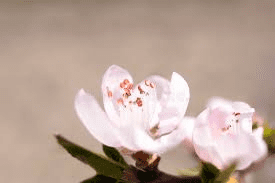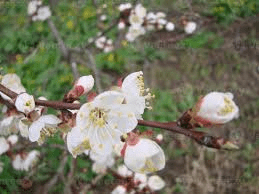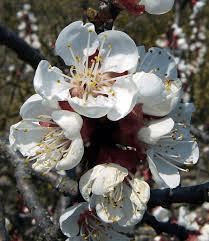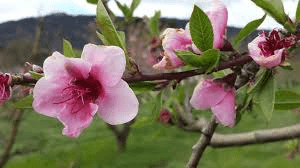Apricot sepals are the small, leaf-like structures that form the outermost part of the apricot flower (Prunus armeniaca). They play a crucial role in protecting the developing flower bud before it blooms. The sepals are typically green and are located at the base of the flower, encircling the petals, stamens, and pistil.
Structurally, sepals are usually thicker and more durable than the petals. They help shield the more delicate parts of the flower from physical damage and environmental conditions such as wind, rain, and insects. When the flower is in bud form, the sepals enclose and protect the petals and reproductive organs. Once the flower opens, the sepals are often visible as a small, cup-like structure at the base of the flower.
In terms of appearance, apricot sepals are typically triangular or ovate and may have a slightly serrated edge. They are often green but can sometimes exhibit a reddish or purplish tinge, especially in certain apricot varieties. The sepals usually persist for a short time after the flower has opened and may fall off as the flower matures and begins to develop fruit.
During the flowering process, the sepals are instrumental in protecting the flower’s developing reproductive organs. They help prevent potential damage from external factors and contribute to the flower’s overall structural integrity. After pollination and fertilization, as the flower transitions into fruit, the sepals may remain attached to the base of the developing apricot fruit, sometimes becoming a part of the fruit’s calyx.
In horticulture, the health of the sepals can be an indicator of the overall health of the flower. Healthy sepals should be intact and free from discoloration or damage. Issues such as fungal infections or environmental stress can impact the sepals and, by extension, the flower’s development and fruit set. For example, diseases like blossom blight can affect the sepals, leading to reduced fruit quality or poor fruit production.
Proper care of apricot trees, including appropriate watering, fertilization, and pest management, helps ensure the health of the sepals and overall flower development. Regular inspection of the flowers and sepals can help identify any early signs of problems and allow for timely intervention to address potential issues.
Aapricot sepals are the protective, leaf-like structures at the base of the apricot flower. They play a key role in shielding the flower’s reproductive organs before blooming and contribute to the flower’s structural integrity. The health and condition of the sepals can provide insights into the overall well-being of the flower and the tree, highlighting the importance of proper horticultural practices to support successful flowering and fruit development.
The Economic Importance and Uses of Apricot Sepals

1. Horticultural Support: Apricot sepals play a role in protecting and supporting the developing fruit. They help shield the flower buds and young fruit from pests and environmental stress.
2. Crafting Material: Dried apricot sepals are used in crafting projects such as making natural decorations, floral arrangements, and botanical art.
3. Mulch: Shredded apricot sepals can be used as mulch in gardens to help retain soil moisture, suppress weeds, and improve soil structure.
4. Composting: Apricot sepals can be added to compost piles. They contribute organic matter and nutrients to the compost, aiding in soil enrichment.
5. Biomass Fuel: Dried apricot sepals can be used as biomass fuel, providing a renewable energy source for heating and power generation.
6. Soil Erosion Control: Sepals can be used to create natural barriers or ground cover to prevent soil erosion on slopes and unstable areas.
7. Animal Bedding: Chopped sepals can be used as bedding material for livestock, providing a comfortable and absorbent surface.
8. Potpourri: Dried apricot sepals are used in potpourri mixtures, adding texture and a natural element to home décor and air freshening products.
9. Natural Fencing: Sturdy sepals can be used to construct natural fences or trellises, offering an eco-friendly and durable fencing option.
10. Educational Uses: Sepals are used in educational settings to teach about plant anatomy, specifically the role of sepals in protecting the flower and fruit development.
11. Decorative Art: Sepals can be used in botanical art and natural sculptures, adding a unique element to various artistic creations.
12. Seedling Pots: Sepals can be used to create biodegradable pots for seedlings, providing an eco-friendly option for starting plants.
13. Eco-Friendly Packaging: Sepals can be used in sustainable packaging materials, such as biodegradable fillers and cushioning for packaging.
14. Soil Improvement: Chopped sepals can be mixed into soil to enhance its structure and drainage, promoting better plant growth.
15. Herbal Infusions: Sepals are sometimes used in herbal teas and infusions, believed to have mild health benefits and adding a unique flavor.
16. Craft Supplies: Sepals are used as part of craft supplies for making wreaths, garlands, and other handmade items.
17. Wildlife Habitat: Decaying sepals provide habitat and food sources for various wildlife, contributing to biodiversity in natural settings.
18. Livelihood: Harvesting and selling apricot sepals can provide income for local communities, supporting economic development through the sale of floral and gardening products.
Read Also: How to Farm and Care for Longtail Tuna Fish (Thunnus tonggol)
The Products and By-products That Can Be Derived From Apricot Sepals

1. Mulch: Shredded apricot sepals are used as mulch in gardening. They help retain soil moisture, suppress weeds, and improve soil structure.
2. Compost: Apricot sepals are added to compost piles to provide organic matter and nutrients, enriching the compost and enhancing soil fertility.
3. Biomass Fuel: Dried sepals are used as biomass fuel. They are burned to generate heat and energy in various applications.
4. Soil Erosion Barriers: Sepals can be used to create natural barriers or ground cover on slopes to control soil erosion and stabilize the soil.
5. Animal Bedding: Chopped sepals are used as bedding material for livestock. They provide a comfortable and absorbent surface.
6. Potpourri: Dried sepals are included in potpourri mixtures. They add texture and a natural element to home décor and air freshening products.
7. Natural Fencing: Sturdy sepals can be used to construct natural fences or garden trellises, offering a durable and eco-friendly option.
8. Educational Tools: Sepals are used in educational settings to teach about plant anatomy and the protective role of sepals in flower and fruit development.
9. Decorative Art: Sepals are used in botanical art and natural sculptures, adding a unique element to artistic creations.
10. Seedling Pots: Sepals can be used to make biodegradable pots for seedlings, providing an eco-friendly planting option.
11. Packaging Materials: Sepals are used in sustainable packaging as biodegradable fillers and cushioning materials.
12. Soil Improvement: Chopped sepals are mixed into soil to enhance its structure and drainage, supporting better plant growth.
13. Herbal Infusions: Sepals are used in herbal teas and infusions, providing mild health benefits and a unique flavor.
14. Craft Supplies: Sepals are used in various craft projects, such as making garlands, wreaths, and other handmade items.
15. Wildlife Habitat: Decaying sepals provide habitat and food for wildlife, contributing to ecological balance and biodiversity.
16. Livelihood: Harvesting and selling apricot sepals can provide income for local communities, supporting economic development through the sale of floral and gardening products.
17. Plant Research: Sepals are studied in plant research to understand their role in protecting flowers and supporting fruit development.
Read Also: Appearance, Features and Farming Guide of Pangasius Fish
Frequently Asked Questions (FAQ’s) About Apricot Sepals

1. What role do apricot sepals play in fruit development?
Apricot sepals protect the developing fruit by covering the flower bud and young fruit. They help shield the fruit from pests and environmental stress, supporting healthy growth.
2. Can apricot sepals be used in crafting?
Yes, dried apricot sepals are used in various crafting projects, including natural decorations, floral arrangements, and botanical art.
3. How are apricot sepals used as mulch?
Shredded apricot sepals are used as mulch around plants. They help retain soil moisture, suppress weeds, and improve soil quality.
4. Are apricot sepals used in any fuel applications?
Yes, dried apricot sepals can be used as biomass fuel. They provide a renewable energy source for heating and power generation.
5. How do apricot sepals help with soil erosion control?
Sepals can be used to create natural barriers or ground cover on slopes, helping to prevent soil erosion and stabilize the soil.
6. Can apricot sepals be used in animal bedding?
Yes, chopped apricot sepals are used as bedding material for livestock. They provide a comfortable and absorbent surface.
7. What is potpourri made from apricot sepals?
Potpourri made from apricot sepals includes dried sepals mixed with other aromatic materials. They add texture and a natural element to the potpourri.
8. How are apricot sepals used in educational settings?
Sepals are used in educational settings to teach about plant anatomy, specifically the protective role of sepals in flower and fruit development.
9. Can apricot sepals be used in eco-friendly packaging?
Yes, apricot sepals can be used as sustainable packaging materials, such as biodegradable fillers and cushioning, reducing environmental impact.
10. How do apricot sepals contribute to wildlife habitats?
Decaying sepals provide habitat and food for various wildlife, contributing to biodiversity and ecological balance in natural settings.
Read Also: Top 20 Proven Benefits of Ginger Plant






